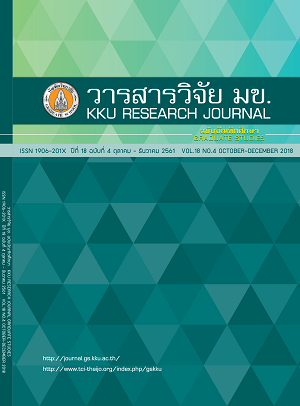Applications of Log-linear Smoothing Models to fit Loss Distribution of Thai Government’s officer Healthcare Benefit
Keywords:
Log-linear smoothing models, Loss modelingAbstract
The purpose of this research was to fit log-linear smoothing models to forecast frequency and severity of loss of Thai government's officer healthcare benefit in case of outpatients who admitted to hospital in 2015. This study attempts to apply the univariate smoothing model to fit loss modeling. The methods take the value of score function of frequency and score function of severity of loss each moments are generalized as standard scores (Z-score). The results of the study revealed, from the selected results for one model from G2 and AIC based on the lowest value showed that both criteria have chosen the same. (1) Univariate smoothing model selects results for one model of frequency of loss from the second model, which consists of 1st - 5th moment. (2) Univariate smoothing model selects results for one model of severity of loss from the first model, which consists of 1st - 4th moment.
References
2. Holland PW, Thayer DT. Notes on the use of log-linear models for fitting discrete probability distributions. ETS. 1987.
3. Moses T, Davier AAv, Casabianca J. Loglinear Smoothing : An Alternative Numerical Approach Using SAS. ETS. 2004.
4. Nikomborirak D, Ruenthip K. Study on organizational reform guidelines to improve the efficiency of the management of the welfare system of government officials. 2011. Thai.
5. Moses T, Holland PW. Selection strategies for univariate loglinear smoothing models and their effect on equating function accuracy. Journal of Educational Measurement. 2009; 46(2): p. 159-176.
6. Limwattananon S, Limwattananon C, Cheawchanwattana A, Silkavute P, Tangcharoensatien V. Forecasted expenditure due to the use of expensive drugs in Civil Servant Medical Benefit Scheme. Journal of Health Systems Research. 2011; 5(2). Thai.
7. Panpiemras J, Wasi N, Manachotphong W. Decomposing health expenditure : The case of CSMBS outpatients in Saraburi hospital. Thailand Development Research Institute; 2013. Thai.
8. Suwatthi P. Statistical inference theory Bangkok, Thailand: Project development and technical documentation. NIDA; 2010. Thai.
9. Holland PW, Thayer DT. Univariate and bivariate loglinear models for discrete test score distribution. ETS. 2000.
10. Akaike H. Likelihood of a model and information criteria. Journal of Eeconometrics. 1981; 16(1): p. 3-14.
11. Pollock DSG. Smoothing with Cubic Splines. Queen Mary and Westfield College. 1999.


